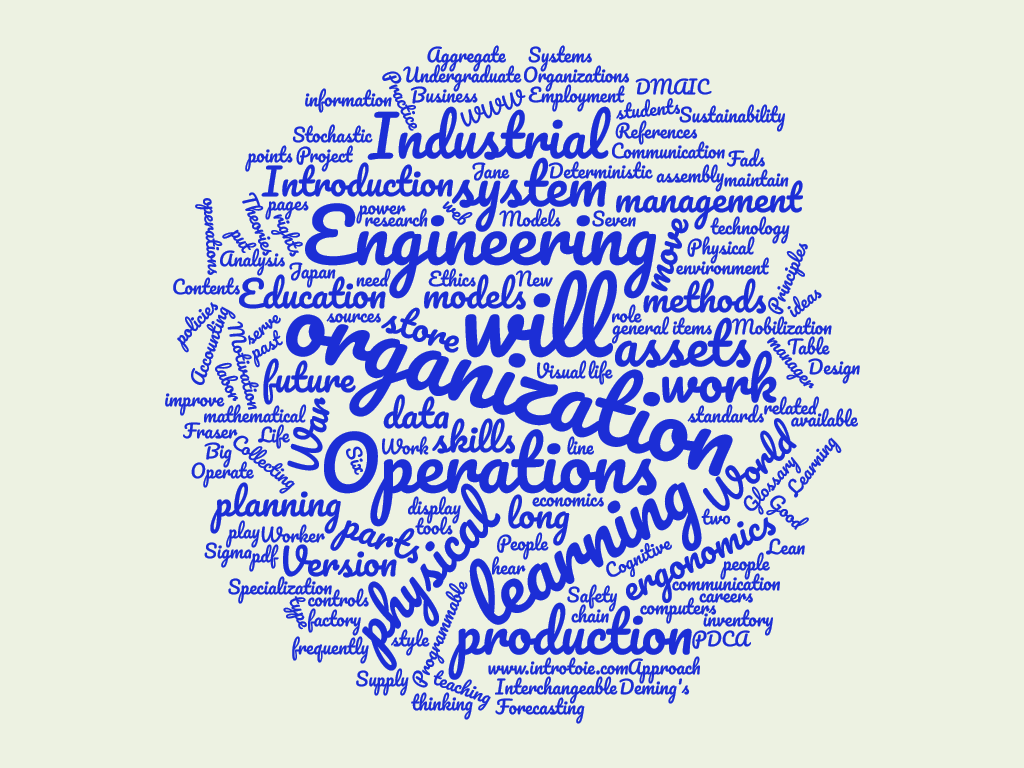4 Big Ideas in Industrial Engineering
Chapter Table of contents

At times while reading this book, you may wonder exactly what you are learning and you may not be able to point to specific new skills and knowledge you have, but I guarantee that you will have new ideas and new ways of thinking by the time you complete this book. By the time you finish reading this book, you will have begun to think like an IE.
How does an IE think?
One example of how an IE thinks is that when something goes wrong – a customer got the wrong shipment, a worker was injured, a plant did not produce the quantity of product that was planned for that day – an IE blames the system, not the people. Until the root cause of a problem is identified, an IE keeps asking “why?”
- Why did the customer receive the wrong shipment?
- Because the wrong shipping label was put on the customer’s shipment.
- Why was the wrong shipping label put on the customer’s shipment?
- Because some shipments were removed from the shipping department.
- Why were the shipments removed?
- Because the customer had made some last minute changes to the order.
- Why did the customer make some last minute changes?
- And so forth.
The IE in this example could end up identifying problems in how customer orders are tracked, in how the sales people identify appropriate products for customers, or in when and how shipping labels are printed and applied to shipments. The IE will probably end up making changes to the physical system (including the information system) and to the procedures used. Perhaps the shipping label should not be printed until the order is actually being shipped.

Big Ideas
The big idea from this example is that an IE blames the system, not the people. Now, that idea may not always be true; yes, sometimes people simply make mistakes, but the IE should always think first, second, and often about how systems can be improved so people don’t make mistakes. An IE tries to set up systems so people do tasks right the first time every time.
Here is a list of ideas that you will read about throughout this book and that we will bring up repeatedly in our discussions:
- If a problem occurs, blame the system, not the people.
- Design the system so people do tasks right the first time every time.
- Design the system so people can do their work efficiently, well, and safely.
- Reduce the variation in a system, so tasks are done consistently.
- If it ain’t broke, it can still be improved.
- Small incremental improvements of a process add up, but more radical reengineering may sometimes be needed.
- A system should help ordinary people do extraordinary work.
- IEs are always thinking “this could be done better.”
- How a person does a job is important in achieving efficiency, quality, and safety.
- The process for doing a task makes a big difference in how efficiently, well, and safely the task is done.
- Achieve quality in goods and services by having good processes, not by inspecting goods and services to fix problems after they have occurred.
- While most engineers design physical objects, industrial engineers design systems. A system includes physical objects, but also includes rules and procedures that aren’t physical.
- The ideas of IE have been around for decades, but the ideas get repackaged and resold periodically: some examples are TQM, CQI, re-engineering, the Toyota system, lean manufacturing, and Six Sigma.
- IEs can work for any organization because IEs improve processes and systems.
- Every organization must scan the environment for change and must think about its place in the global economy.
- The customer is not always right, but the customer comes first.
- All products and services involve both products and services.
- A team of people using good team processes will produce better work than any one of the individuals could have.
- Decisions should be based on facts, logic, and analysis, not on hunches.
- People can usually grasp information better, especially data, if it is displayed visually.
- Don’t use information technology to computerize an inefficient process; make the process more efficient first.
- Happy employees are productive employees.
- An IE must engage in lifelong learning. You must keep up with new technologies, new software, and new ideas.
Of course, there are situations in which any of the above statements could be untrue. You don’t want to stick blindly to any one of these statements all the time. But most of the time, the above ideas are good ways for an IE to think.
It is about you.
One big, final idea that you will see throughout this book is that industrial engineering is about you. You can apply industrial engineering concepts to your own life. It’s up to you to ensure that you use good processes for doing industrial engineering. As an IE you work on improving the system of the organization for which you work; as an individual, you work on improving the system that is you.
Seven Habits of Highly Effective People
Many students have read and have recommended very strongly The Seven Habits of Highly Effective People, by Stephen Covey. Those seven habits are:
- Be proactive.
- Begin with the end in mind.
- Put first things first.
- Think win/win.
- Seek first to understand, then to be understood.
- Synergize.
- Sharpen the saw.
Together, the seven habits help you apply IE ideas to make yourself an effective person. As an IE, you do your work in a context: the people you work with closely, the organization that employs you, the area where the organization is located, the state where you live, the country where you live, and, of course, the world. The systems approach, which I’ll explain in the Systems Thinking chapter, urges you to think about the big picture. It’s important to always think about the process you are studying in its larger context. You don’t want to make a change that improves the process but that does damage to the larger system. I like the phrase “think globally, act locally.”
Exercise
Find or create an image that illustrates one of the Big Ideas. Your instructor may ask you to submit your image with a description of why you chose it and how it relates.

